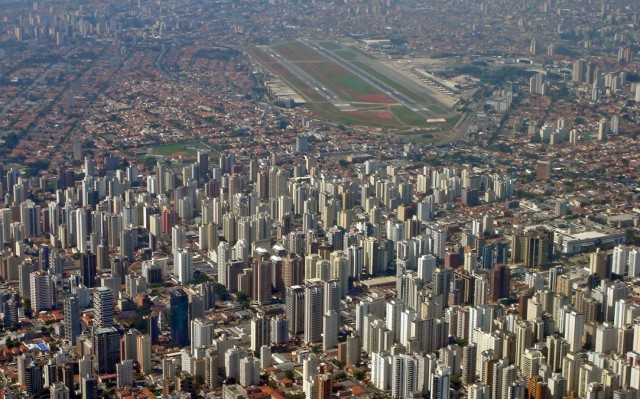Sao Paulo
SAO PAULO IS THE largest city in BRAZIL and serves as the capital of the state of Sao Paulo. With a metropolitan area population nearing 20 million at the start of the 21st century, Sao Paulo is the biggest city in South America and one of the fastest-growing urban areas in the world. The city is the industrial center of Brazil, located about 30 mi (48 km) inland from the city of Santos, which serves as Sao Paulo's ATLANTIC OCEAN port.
Jesuit missionaries founded Sao Paulo in 1554 as a small Native American settlement, the first in highland Brazil. The Jesuits hoped to use the settlement as a base to convert the region's native inhabitants to Christianity. The name of the city is due to the fact that they established the city on January 25, the anniversary of the conversion of Saint Paul. Sao Paulo grew slowly at first, reaching a population of just 300 by the end of the 16th century. The settlement gained the status of a township in 1560. In its first century of existence, there was much Native American influence in Sao Paulo. The basic housing structure was an indigenous-style straw-covered lodge. Residents ate local foods, slept in hammocks rather than beds, and established unions with Native American women.

In 1683, Sao Paulo became the capital of the captaincy. Sao Paulo's importance grew in the 17th century, as it became the base of bandeiras, which were expeditions into the interior of Brazil in search of Native American slaves, gold, silver, and diamonds. Indeed, the town became the center of the native slave trade.
Authorities designated Sao Paulo as a city in 1711. This was a reflection of an economic shift toward southern Brazil from a gold and diamond rush. Increased trade and wealth enriched some elite residents of Sao Paulo. They were able to adopt more European styles in areas such as fashion, housing, and furniture. They also began to invest profits in cash crops such as coffee, which would later transform the city. Nevertheless, the city remained largely agrarian and not very prosperous compared to the much larger city of Rio de Janeiro. By the late colonial period, Sao Paulo had a population of 24,000, making it the third largest city in Brazil.
After Brazilian independence in 1822, the city still retained much of its colonial character. Sao Paulo underwent a significant transformation in the later part of the 19th century. The coffee industry came to dominate the state of Sao Paulo by the 1860s and 1870s, providing many jobs to the region. Numerous immigrants from Europe and elsewhere moved into the area.
The coffee industry transformed the city, which greatly benefited from the economic boom. By the 1870s, the provincial government spent half of its budget on the city of Sao Paulo. Authorities spent most of the money on urban improvements that benefited the city's wealthy residents. The middle and lower classes meanwhile saw little improvement. On the contrary, the number of poor residents grew, many of whom lived in tenements known as corticos. As a result of the prosperity and immigration created by coffee, the city of Sao Paulo began to grow and industrialize. Between 1880 and 1900, the city's population grew from 35,000 to 240,000, reaching annual growth rates as high as 14 percent in the 1890s. Some in Sao Paulo also began to reinvest coffee profits in factories and the city soon become the country's key industrial center. At the same time, there was already evidence of haphazard construction, poor sanitation, and a lack of adequate public services.
By the early 20th century, the city possessed many textile mills, shoe factories, and other industries. Heavy industry appeared by the time of World War II. In the post-war era, many international automobile companies such as Ford, General Motors, and Volkswagen established plants in the Sao Paulo metropolitan area. Thus, the city's working class continued to grow in importance. In fact, Sao Paulo's workers played an important role in bringing about the end of military rule in Brazil in the 1980s. The city's working class, with the support of the Catholic Church, challenged the power of the military government through a series of strikes.
While in the late 19th century Sao Paulo had only about 10 percent of the population of Rio de Janeiro, Brazil's largest city, by 1970 it had become the biggest urban area in the country. This rapid growth in the 20th century brought with it many urban problems. Sao Paulo's economy could not absorb such an influx of new inhabitants. Many residents are therefore unemployed or underemployed. Shantytowns known as favelas have grown up around the city. Traffic congestion on Sao Paulo's streets has become a major problem, and noise and air pollution plague the city's residents.